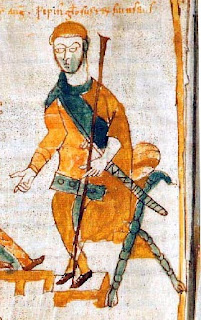At a time when fear of demons was common, they were "seen" everywhere: causing children to be ill, folk to go mad, cows to dry up, crops to fail, wells to go bad, etc.—they were constantly interfering with human life. One of them was considered the "patron demon of scribes" because he was blamed for errors in manuscripts. His name was Titivillus, sometimes Tutivillus, but in some of the earliest manuscript mentions, their middle letter is unclear and could be n or u/v, so it is written sometimes as Titinillus.
Despite the connection to Caesarius, and a reference in the writings of John of Wales, who died c.1285, as a demon who existed to introduce errors into scribal work, the Oxford English Dictionary's entry attributes the first reference to Peter Paludanus (c.1275 - 1342), who became Latin Patriarch of Jerusalem. The OED suggests the name of the demon might come from Latin titivillitium, a "mere trifle." Titivillus must have been looking over James Murray's shoulder, because Titivillus is clearly found in John of Wales' work long before Peter Paludanus would have been writing. In the Tractatus de Penitentia ("Tract on Sin"), we find
Fragmina verborum titivillus colligit horum
Quibus die mille vicibus se sarcinat ille.
Titivillus gathers up the fragments of these words
with which he fills his sack a thousand times a day.
He gets mentioned in a lot of medieval sermons as a reminder to be ever on guard against error and sloth. Titivillus became a character in medieval Mystery Plays. In the 15th century morality play Mankind, Titivillus is summoned by Mischief and other distractions to make Mankind's life difficult, but only after the audience is asked to pay extra money to make him appear (presumably his costume was suitably fabulous to charge extra). Titivillus' standing as a literary figure fades after that, and Shakespeare uses "Tilly-vally" a couple times when a character brushes off a complaint worthy of Titivillus' sack.
Concerning the phrase "fills his sack." This is not about inducing errors into manuscripts, but something else. Titivillus' career gets conflated with that of other popular medieval figures to watch out for: a "recording demon" and a "sack demon." That's an entirely different post.
Titivillus' presence can still be detected, such as in the fact that the OED (and I cannot believe I have never mentioned it and its mentor James Murray before) misses the earliest reference (but then, I am reading from the first edition; it has been updated). He influences my own work: although I proofread my post hours after writing it and being away, I still miss errors, which are found and shared by a very good friend; I know he is a good friend because he reads daily! (Come to think of it, that friend's name is Nick, and isn't "Old Nick" a name for the devil? Maybe he's trying to undo Titivillus' history of work?)
Well, more demons tomorrow.





























